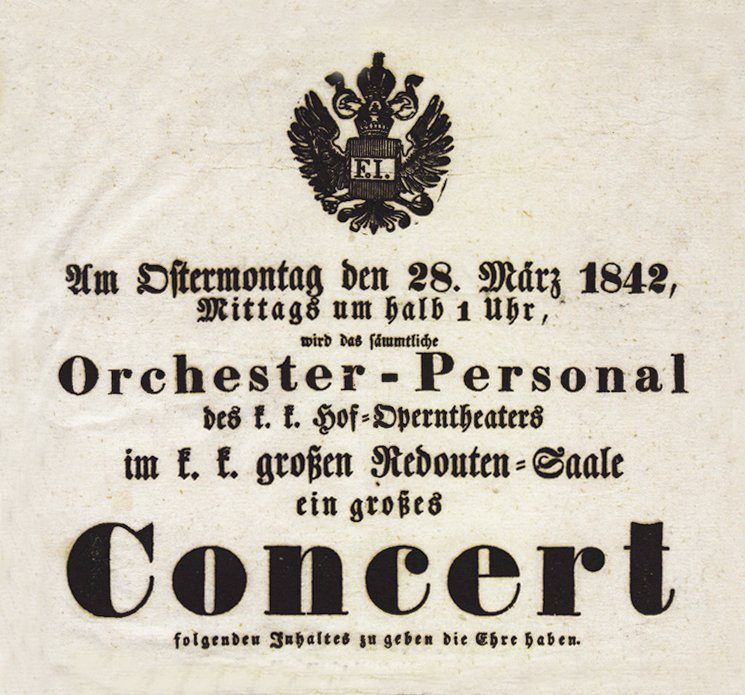
On the eve of March 28, 1842, Vienna—a city already buzzing with the whispers of musical innovation and cultural renaissance—was about to witness an event that would carve a new cornerstone into its artistic edifice. The Imperial Opera Theater, a beacon of operatic and symphonic excellence, set the stage for a concert that would mark the birth of the Vienna Philharmonic Orchestra.
Imagine the scene: gas lamps casting a warm glow on the opulent interiors, the rustle of silk and the murmur of anticipation as Vienna’s elite gather, awaiting the emergence of maestro Otto Nicolai. As the conductor raises his baton, the air thick with expectation, the orchestra delves into a repertoire that would forever define the essence of classical music.

But who were these pioneers, these artisans of sound? Drawn from the venerable ranks of the Imperial Opera Theater, each musician was a master in their own right, united by a shared vision of bringing an unparalleled symphonic experience to the heart of Vienna. It wasn’t just their skill that set them apart; it was their profound connection to the city’s operatic roots, a heritage that infused every note with a depth of emotion and a resonance that spoke directly to the soul.
The pieces chosen for this monumental evening were more than just compositions; they were narratives woven into the fabric of Vienna’s cultural tapestry. While records of the exact program remain elusive, one can imagine the air filled with the strains of Beethoven, Mozart, and perhaps Nicolai himself—each note a testament to the enduring legacy of these composers in the pantheon of classical music.
The venue, with its storied walls and echoing chambers, was not merely a backdrop but an active participant in the concert’s magic. It was here, amidst the grandeur and the history, that the Vienna Philharmonic Orchestra’s sound first intertwined with the city’s soul, creating an indelible bond that continues to define both the orchestra and Vienna itself.
As the final notes faded into the night, the audience knew they had witnessed not just a performance but the dawn of a new era. The orchestra’s debut was a declaration of musical excellence, a promise of the innovation and passion that would become its hallmarks.
Embarking from that pivotal night in 1842, the Vienna Philharmonic Orchestra has woven a rich tapestry through nearly two centuries of musical and cultural evolution. From the gas-lit grandeur of the Imperial Opera Theater, this ensemble has journeyed through epochs, embracing change while steadfastly upholding the sanctity of its origins.
In the years following its debut, the orchestra became synonymous with Vienna’s vibrant cultural scene, performing works that spanned the breadth of classical music’s golden era. Under the guidance of a lineage of maestros, each bringing their own unique flair and philosophy, the orchestra explored new territories of sound and expression. Names like Brahms, Bruckner, and Mahler not only graced the programs but often stood at the helm, directing the orchestra through their own compositions, infusing performances with unparalleled authenticity and insight.

As the world around it undulated through the tumults of history—revolutions, wars, and the relentless march of progress—the Vienna Philharmonic remained a beacon of continuity and artistic integrity. Even as the 20th century introduced new challenges, from the strains of avant-garde to the advent of digital music, the orchestra navigated these waters with grace, adapting without sacrificing its core identity.
The introduction of the renowned New Year’s Concert in 1939 marked another milestone, becoming a cherished tradition that brought the joy and sophistication of Viennese music to millions worldwide. Through radio waves initially and then television broadcasts, the Vienna Philharmonic extended its reach far beyond the concert halls, becoming a household name and an ambassador of classical music across the globe.
In the latter half of the 20th century and into the 21st, the orchestra’s repertoire expanded to include contemporary pieces, showcasing the works of living composers alongside the timeless classics. This evolution reflected a broader shift within the classical music landscape, as traditions merged with modernity to create a dialogue between the past and present.
Despite these forays into new musical domains, the Vienna Philharmonic’s heart remains in the intimate connection it shares with its city. The musicians, still drawn from the ranks of the Vienna State Opera, embody the spirit of their forebears, serving as custodians of a rich musical heritage while continuing to enchant new generations of listeners.




Leave a Reply